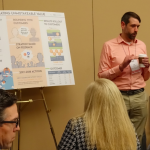The key to any survey is not the results—it’s how well we, as leaders, share the results with those who provided the feedback. It’s also how well we communicate actions taken based on the feedback. System-wide engagement surveys are important tools for driving actions that create best places to learn and work.
In the School District of Altoona, located in Altoona, WI, leaders administer and share survey results with staff, as well as with students. The Student Engagement Survey has been extremely impactful. It drives home the idea that the stakeholders who actually take the survey should get to see the results.
Research tells us student engagement is strongly related to student achievement. In Altoona, the purpose of measuring student engagement is to provide insight into how students perceive their learning environment. This helps the schools continue to do what engages students and work toward improving targeted areas. Leaders and teachers in the school district are committed to using feedback from the survey, as they believe perception is reality.
This summer, at our What’s Right in Education conference, Altoona leaders Dr. Connie Biedron and Daniel Peggs, presented why they believe so strongly in the Student Engagement Survey. Not only did they explain how the survey gives a voice to the students, builds capacity and appreciation with staff, and captures the perceptions of students, but they also showcased the results of implementing the survey at their schools.
As we become more proficient in our survey rollouts, always looking to gain positive feedback to guide our continuous improvement, we found ourselves eager to understand the “why” behind the answers we received from our first student surveys.
In brainstorming next steps, our administrative team thought the logical next step would be to rollout the survey results to our students to garner the knowledge behind their responses and create a plan to better serve our students and improve their positive feelings about all aspects of our school district.
How they did it:
The Student Engagement Survey Rollout is a process cascading all the way from the administrative team to students in the classroom. Here are the steps taken:
- Student Engagement Survey is given and data received
- District administrative team discusses
- Building leaders create a Results Rollout plan that works for their school
- Teachers are trained
- Teachers gather feedback and conduct a “rollout” with students to get their ideas
- Themes are identified from rollout feedback
- Teachers action plan what needs to change or stay
 What they learned:
What they learned:
On a 5-point scale, the district scored 4.35 on the survey item, “My teacher cares about me.” That is truly outstanding. Teachers shared this score with students and got even more feedback regarding how to continue to achieve and improve the “teacher cares about me” score in the current year, next year, and long term.
Major takeaways included the opening of our eyes to the needs of our students. The process increased teacher ownership and understanding of the rollout process, student perceptions, and issues. We created action plans based on the real perceptions of students. Most importantly, students felt like they were heard and their opinions matter.

Through the Student Engagement Survey, leaders were not only able to gain useful feedback regarding strong and weak points, but also were able to get a better idea of the “why” behind the scores and possible solutions to improve results.
How does your organization measure employee and student engagement? Is rolling out results to the same people taking the survey part of the practice that shows stakeholders you care about improvement?
KK Owen, Studer Education℠




